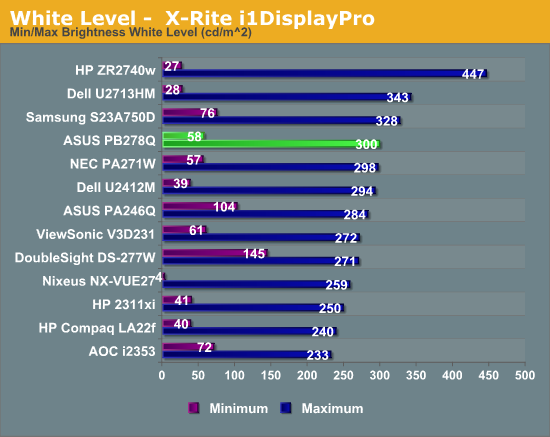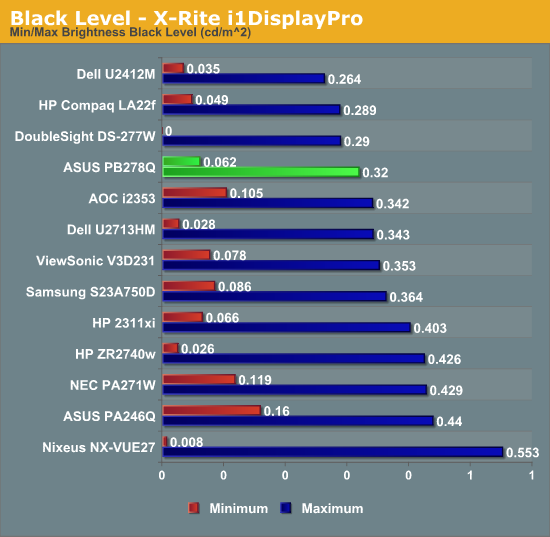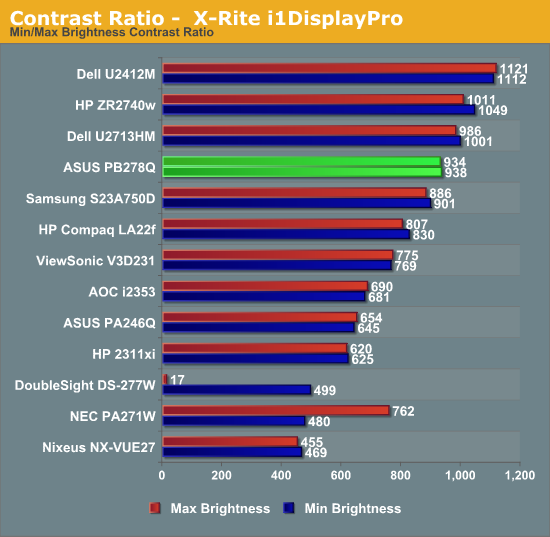ASUS PB278Q Review: An IPS Competitor Emerges
by Chris Heinonen on November 19, 2012 11:00 PM ESTASUS PB278Q Brightness and Contrast
ASUS says that the PB278Q can do 300 nits at maximum brightness, and that spec hits it right on the head. With a full white screen and the brightness pushed up all the way, I got exactly 300 nits of light output from the display. One of PLS' advantages over IPS is supposed to be the ability to let more light through, though this number is very close to what other 27” displays achieve. It might be able to do this using a lower powered LED backlight, and we will test that out in power usage later to see if that is the case.
With the brightness at minimum, we get 58 nits of brightness which should be low enough for virtually every user. The lowest that most users might set a display to is probably 80 nits, and so as long as a display goes below that level I think that is a perfectly acceptable minimum brightness level. This range from 58 to 300 should also accommodate virtually all users for their brightness requirements.

Before measuring the black level, I made sure to disable dynamic contrast, as it would likely just disable the LED backlight and give a result of 0 for a black screen. Since no one really uses an all black screen in this way, I don’t feel that testing it is appropriate. With the backlight at maximum the black level was 0.32 nits, and at minimum it was down to 0.062 nits. This is a decent minimum black level for a display, and good for IPS, but not as exceptional as some displays can manage.

The black level looks better when used to calculate the contrast ratio of the display here. With a contrast ratio right around 935, this is right around what we see for other 27” IPS displays. The PLS display seems to be equal to what other IPS displays can manage, not really much better or worse, but right down the middle of the range.

Brightness and Contrast details are right in line with what we expect from an IPS display, and since PLS is very similar to IPS we see very similar results. The peak brightness is lower than some IPS displays, but most people don’t use more than 300 nits and we will see later if this enabled ASUS to use a lower power backlight.










55 Comments
View All Comments
cheinonen - Tuesday, November 20, 2012 - link
I don't have the 21:9 Dell, but I have the LG EA93 being written up now.jjj - Tuesday, November 20, 2012 - link
That's great,looking forward to the review.I guess it's the same penel,Dell might use it better but the LG could be cheaper.bcseime - Tuesday, November 20, 2012 - link
The values for U2412M in the processing lag comparison graph does not match the value in the total response time graph.Avalon - Tuesday, November 20, 2012 - link
Ahh, I see you beat me to it.JarredWalton - Tuesday, November 20, 2012 - link
Had the same name twice; fixed now with the slower U2713HM correctly labeled. Thanks!dishayu - Tuesday, November 20, 2012 - link
You should probably try an include a couple of 120Hz LCDs like the Benq XL2410T, atleast in the input lag charts. I'd like to see how far behind IPS panels are, and of course, how close to CRT can a 120Hz LCD get.h107474 - Tuesday, November 20, 2012 - link
Actually they should use the Hazro HZ27WC for input lag comparison of 27" displays. It is also based on the LG panel but it's the ultra cut down cheap version with no scalars, only DVI input and no OSD at all! This means ultra low lag and is why I bought it. Check out the TFT Central review and input lag measurements below:http://www.tftcentral.co.uk/reviews/content/hazro_...
HisDivineOrder - Tuesday, November 20, 2012 - link
I agree. Input lag is quite commonly a problem with monitors with built-in scalers. But then, that was true years ago, too. Not sure why it's still surprising reviewers today...The shocker is they haven't figured out a way to fix or improve this problem.
cheinonen - Tuesday, November 20, 2012 - link
The question was really if using the 1:1 mode with non-native content instead of Full mode, so there was no scaling, would get around the lag hit of the scaler, but it does not do that. I'd like it if monitor vendors could make a lower lag mode, as some TV makers do with their game console modes, but I haven't seen one that has that effect yet.120 Hz LCDs are on the list to do soon and get some better numbers on them.
Olaf van der Spek - Wednesday, November 21, 2012 - link
1:1 requires more buffering than normal scalingBut nobody has been able to explain yet why normal scaling takes so much time.